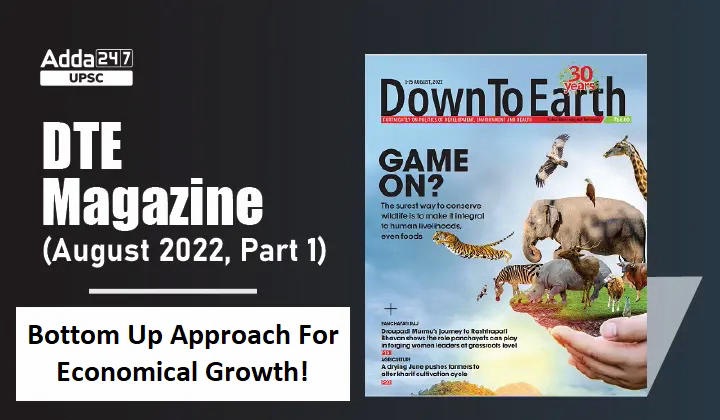Table of Contents
Bottom Up Approach For Economical Growth: Introduction
- In the face of the covid-19 pandemic and the rise in food and fuel prices, it may appear difficult for the country to reach its US $5-trillion economy target by 2025.
- But a study conducted by the National Council of Applied Economic Research (NCAER) shows that the targets are easily attainable by following the bottom-up approach recommended by the Department of Promotion of Industry and Internal Trade (DPIIT).
Bottom Up Approach For Economical Growth: How to move ahead with Bottom Up Approach?
- In 2018, a working group constituted by DPIIT proposed to treat districts as the primary unit for planning and policy interventions so that they contribute to the accelerated growth of the Indian economy.
- Key policy intervention is to prepare strategies for the districts centred around their local strengths and economic activities.
- To prepare a roadmap for implementing the working group’s recommendations, NCAER between 2019 and 2021 conducted a series of studies in the districts of Ratnagiri and Sindhudurg in Maharashtra.
Bottom Up Approach For Economical Growth: 4 Key Areas Identified By NCAER
- The NCAER has identified four key areas that can help fast-track the economic growth of districts
i) finding potential sectors of growth
ii) implementing actions, such as assessing capacities of the district and identifying potential investors and sites for undertaking growth activities
iii) offering support to the district development unit as well as recommendations for course correction, and iv) sharing the findings with local communities or the target groups. - These areas of economic growth can then be implemented by leveraging existing central- or state-sponsored government schemes, notes NCAER.
Bottom Up Approach For Economical Growth: Infrastructure is the Key
- NCAER recommends setting up necessary facilities under existing central government-sponsored schemes.
- Development of storage facility by the establishment of warehousing infrastructure comes under the ‘Rashtriya Krishi Vigyan Yojana (RKVY)’ that incentivises investment in agriculture and allied sectors.
- Similar provisions are also there in the Centre’s ‘Cluster Development Programme’, which aims to enhance productivity of micro and small manufacturing enterprises, and the ‘Mission for Integrated Development of Horticulture’ that promotes holistic growth of the horticulture sector.
- Another suggestion to boost trade is Centre’s One District, One Product scheme.
- The Blue Revolution: integrated development and management of fisheries, a central government-sponsored scheme, has provisions to set up basic facilities at landing points, processing units, effluent treatment plants, aquaculture centres and to promote deep-sea fishing.
- Crab cultivation can also be encouraged through subsidies or research grants under the Centre’s Mangrove Protection and Employment Generation Scheme 2017-18.
- The Pradhan Mantri Matsya Sampadan Yojana can help develop a framework for fisheries.
- For tourism, NCAER encourages homestays and improving security and safety, basic amenities and cleanliness under the Centre’s Bed and Breakfast Scheme.
- NCAER notes that local communities and resources hold the key to India’s economic growth.
- In districts, institutions like NABARD (National Bank for Agriculture and Rural Development), Marine Products Export Development Authority and the Agricultural and Processed Food Products Export Development Authority can implement certain projects to boost economic growth.



 TSPSC Group 1 Question Paper 2024, Downl...
TSPSC Group 1 Question Paper 2024, Downl...
 TSPSC Group 1 Answer key 2024 Out, Downl...
TSPSC Group 1 Answer key 2024 Out, Downl...
 UPSC Prelims 2024 Question Paper, Downlo...
UPSC Prelims 2024 Question Paper, Downlo...
